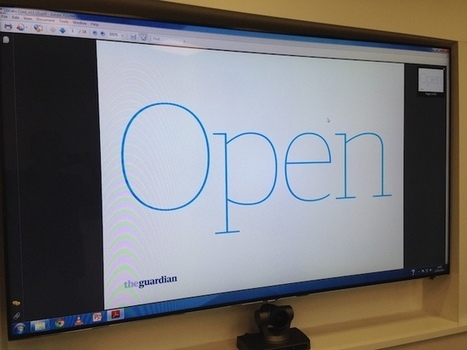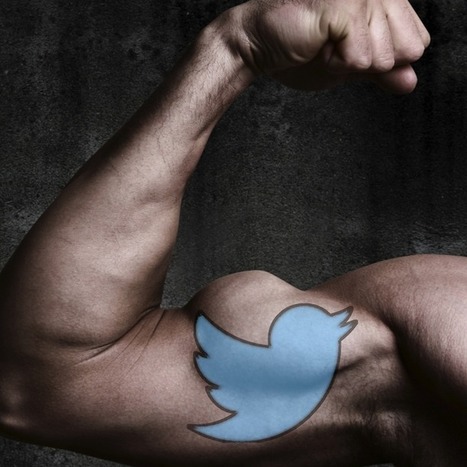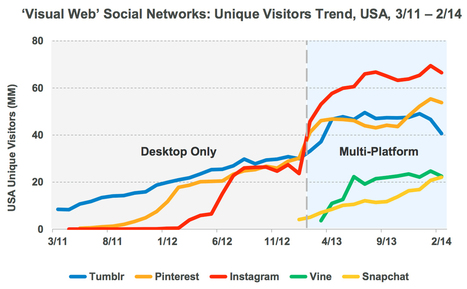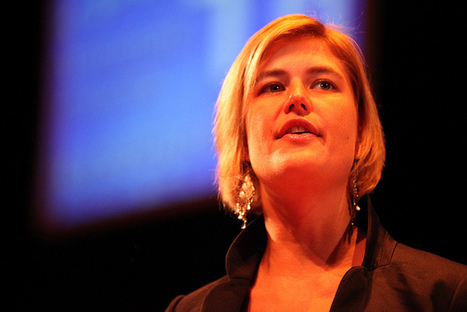 Your new post is loading...
 Your new post is loading...
What if, in the mad dash two decades ago to repurpose and extend editorial content onto the Web, editors and publishers made a colossal business blunder that wasted hundreds of millions of dollars? What if the industry should have stuck with its strengths—the print editions where the vast majority of their readers still reside and where the overwhelming majority of advertising and subscription revenue come from—instead of chasing the online chimera? That’s the contrarian conclusion I drew from a new paper written by H. Iris Chyi and Ori Tenenboim of the University of Texas and published this summer in Journalism Practice. Buttressed by copious mounds of data and a rigorous, sustained argument, the paper cracks open the watchworks of the newspaper industry to make a convincing case that the tech-heavy Web strategy pursued by most papers has been a bust. The key to the newspaper future might reside in its past and not in smartphones, iPads and VR. “Digital first,” the authors claim, has been a losing proposition for most newspapers....
The Guardian has been a journalism leader. Can it build a business strategy that can match its growing global reach?
The Guardian is an enigma.
Long a storied editorial brand, it’s been propelled toward the top of global news audience, both by its open strategy and its hard-nosed journalism. In the past year, it’s broken story after story on NSA spying as the primary recipient of the Edward Snowden files. It’s also expanded its efforts in both the U.S. and Australia, enlarging its global readership. With “open” as its watchword, The Guardian has pushed into every nook and cranny of the social sphere, ascataloged here at the Lab.
But it’s also the Rodney Dangerfield of commercial journalism: It gets no respect. That contradiction — between a worldwide reach and respect and a business strategy that has seemed unstrategic — may be passing into history....
News media companies are not bringing in enough digital advertising revenue because too little of their audience engagement is digital. Is an international industry research project the answer?
According to comScore, in the United States, 62% of digital users visit newspaper Web sites, yet newspapers account for only 8% of total visits, 1.7% of time spent, and 1.5% of pages visited. One has to ask why a medium that is so rich in content enjoys so little traction....
The consequence of this fact is reflected in our industry’s financial reality. It is no coincidence that globally the KPIs of engagement online — visit frequency times pages viewed times time per page — are 5% of those in print, and digital revenues are typically around 5% of print.So why are newspapers deriving so little revenue from digital advertising? Because they are deriving too little of their audience engagement in the digital space. The correlations are indisputable.In part, this is because of a historical defensiveness. But in reality, today, it is because we are not confronting what the analytics could be telling us. Hence the recruiting drive.Solve the audience conundrum and we solve everything...
The New York Times Company did the world of journalism a big favor today.The company finally disclosed the exact revenues of its digital business.The numbers were impressive. And they made clear that no one ever needs to fret about the future of journalism again.Specifically, the New York Times reported that the revenue of its digital business is now about $360 million a year....
Does this strike you as strange? Everything I read and hear keeps telling me that newspapers are a dying industry. Circulation is way, way down. Everyone's getting information online nowadays. No one (besides me) reads newspapers any more.
So why, in the face of all this negative opinion about print media, would one of the world's most well-known and admired investors invest money in print media? I've never met Warren Buffett or had the opportunity to interview him for this column. I'm not privy to the details of this deal. And for all I know there may be a treasure chest of gold buried underneath the offices of the Press of Atlantic City.
But assuming that's not the case, I can think of a few good reasons why he would do this--reasons that have little to do with the newspaper business, but have a lot to do with business in general....
... It was an industry-wide response, and readers noticed, Brusic said. "Imagine it's your daily coffee. Each time you put down your money the cup gets smaller and the brew gets weaker. That's essentially what's happened to American newspapers. We took things away from people and at the same time gave content away free on the web. How crazy is that? The industry committed a kind of institutional suicide over time."Some, like the Rocky Mountain News, closed. Others, like the San Francisco Chronicle, limped on, feeble, malnourished versions of former selves....
How do you get your news? Personally, I get mine primarily from Facebook. As my job requires that I monitor and update different brands' pages, it's pretty likely that you'll find me with the Facebook tab open.... While I may be an addict—I mean hello, it is my job—I am not the only one who scours social networks for news. According to a Pew study, one third of adults under 30 access their news via social networks. 19% of all Americans got news from a social network like Facebook, Google+ or LinkedIn yesterday (up from 9% in 2010). This study was conducted in 2012. Being that we're now in 2013, I can only imagine it being a higher percentage to date....
Winning in digital media now boils down to a simple equation: figure out a way to produce the most content at as low a cost as possible.
In recent years, new players like The Huffington Post burst onto the scene by pumping out a dizzying amount of content each day. The company has 532 full-time editorial staff producing about 1,200 pieces of content per day (and that’s not including the 28 full-time blog editors who oversee the 400 pieces of content per day coming from its blog). All this content generates 43 million pageviews per day, per Comscore. The pageview race now stretches far beyond HuffPost, as many publishers combat low ad prices with high volume.
Even old publications, like Forbes, are taking part in the pageview race. It has 50 on its editorial team. However, it also has about 1,000 contributors. Between the two, Forbes puts up about 400 posts per day and sees 4 million pageviews per day, per Comscore. The company doesn’t separate out how much the staff and contributors put out. But last year, the company posted its best financials since the 2008 industry collapse and saw digital ad revenue spike 19 percent year-over-year. Quantity pays the bills....
...The company is finding that the most popular content for tablets depends on the title. Golf Digest sees great success with video. Generally speaking, long-form editorial content like actual stories, video and slideshows do well across the board because the tablet is a lean-back device, where consumers aren’t looking for short snippets of content like they are on a mobile phone, for example.
“If you look at the time of day with highest tablet usage it’s usually during prime time or on the weekends,” Reynolds said. “That’s why we are developing tablet-specific content to fit that different mindset. We’re not worried about tablet usage cannibalizing Web usage because Web, tablet and mobile, are all part of a complementary ecosystem.”
Reynold’s said that the biggest opportunity for Conde Nast in the tablet space is the amount of data is has on subscribers. It gives the publisher a look at the preferences that people have for content and advertising on specific devices and Conde Nast can optimize based on that.
... Scribble’s traction is international; its ScribbleLive real-time content creation and distribution platform is available in 14 languages and used by the biggest media brands, including the Associated Press, Reuters, CNN and ESPN to name a few. I spoke with Scribble CEO and co-founder Michael De Monte about the raise, and his vision for the company.
He pointed out that Scribble recently launched ScribbleMarket, a way for brands to easily syndicate their live content, and to find said content from other sources for use on their own site. Licensing can be free or paid, and this lets news agencies quickly leverage their reporting resources for additional income streams, by providing not just static articles for syndication as has been the case, but full-featured, interactive real-time content that’s being dynamically updated from a single backend.
quiet“The marketplace for us is the exciting component of what we’re building,” De Monte said. “This opportunity to share content in real time, becoming like the iTunes of real-time content has a lot of potential to change the face of media.”...
Not long ago, the media looked at the web as if it was an awkward, unwanted stepchild. Today, the reverse is arguably true, with debate growing over whether social networks such as Twitter will overtake beacons of journalism like The New York Times. At last month's Milken Institute Global Conference, PayPal co-founder Peter Thiel said he thinks Twitter will outlast The Times. His reasoning: Its business strategy is more solid than that of the storied newspaper. The debate got journalists talking on forums such as Muck Rack, with many people disagreeing. Some said it isn't a mutually exclusive relationship, or that one's success is predicated on the other's failure....
BuzzFeed gets free content, users get exposure, we get 11 Engagement Photos That Will Make You Happy You’re Single. ... The department devoted to creating this “old school” content is known as BuzzTeam. Their focus is anything shareable — lists, animals, nostalgia. The kind of content that BuzzFeed’s loyal readers have become hyper-familiar with. Many, in fact, have consumed so many such BuzzFeed posts that they’ve become adept at mimicking both their tone and their viral success. Earlier this month, BuzzFeed’s editors took a step toward giving those faithful followers a little more of the spotlight they crave. Shepherd, along with a staff of four, now run BuzzFeed Community, a content-producing vertical of its very own, complete with featured posts by community members and a leaderboard with the latest on who’s posts are getting the most traffic, likes, comments, and badges. It’s a competitive place, and anyone can join and enter the fray....
Twitter is a frenemy," said Jeff Zucker, CNN's new president, as reported by MediaShift. Jeff Zucker was describing the cable news network's relationship with social media and added, “the network uses, relies on -- and is scared by -- social media.” Twitter had a marquee moment last week, particularly late Friday afternoon and evening, that should scare most television news outlets in the business of reporting breaking news. That’s when Boston Marathon bombing suspect Dzhokhar Tsarnaev was cornered by police, trapped and almost bleeding to death inside a covered boat in a backyard in Watertown, Mass....
|
I learned many lessons during my eight years at AOL, none bigger than this: don't let any measure of success blind you to what's in front of your face. In the early 00s, AOL raked in the dial-up dollars.
...For me, statistics like these confirm the news business is on another collision course. A decade or more ago, journalism collided with the freedoms of digital publishing. Next came the collision with social media. Now, it’s colliding with mobile, social and the visual Web. Journalists should take note. Basically, they’re livelihood depends on revenue from paying subscribers and ad dollars. About 75% of ad dollars at media companies with magazines or newspapers still come from those properties (at FORBES it’s down to 45%). Often, it’s even more than that. I suspect traditional revenues at TV and cable networks with big Web sites account for the same.
Mobile ad rates are often one-third of desktop rates, now the main source of digital revenues. So, if traditional ad revenues remain flat at best, if digital pay walls work for only the few, if more news is consumed on smartphones, well, the math doesn’t tell a pretty story unless mobile solutions are found....
Hal Varian, Google’s chief economist, talked about the challenges facing the newspaper business in a recent presentation in Italy, and showed that he understands those challenges better than most media executives.
From time to time, media reports on the latest tectonic shift in digital devices and the associated increase in time we spend online are a prophesy - the death of all TV viewing is imminent. Statements like this one recently, "the steady increase in online traffic is cannibalizing TV viewing and effectiveness," have been uttered by pundits periodically over the past decade or more, driving hysteria throughout the industry with marketers left to wonder if it is truly and finally the end of TV advertising as we know it. Isn't it inevitable?
Turns out the answer is 'yes' and 'no'. TV viewing behavior has been permanently altered, and the change (while glacial vs. 'shock and awe') has been sweeping. That said, the net real effect on TV's pivotal role as THE video medium has been minimal – indeed, online viewing has been growing in tandem with not at the expense of overall TV viewing. BOTH online and TV platforms are witnessing record engagement numbers, with television still very much at the helm. Indeed, traditional, living room, TV consumption has grown year-over-year in the U.S., and continues to dominate as consumers seek out appealing entertainment and information[1]. W
ith growing consumer appetite for content and increasing dexterity with mobile devices, adoption of smartphones and tablets will continue to rise, but ALL indications are that television will remain the glowing centerpiece in the living room for the foreseeable future....
Innovative storytelling, audience engagement, and financial flexibility are key ingredients for newspapers to cope with pressures from competitors, budget constraints, and the speed at which technology is changing."It came as no surprise when The New York Times took home a Pulitzer for 'Snow Fall' - the immersive multimedia package impressed journalists and web designers alike with its seamless integration of text, audio, videos, photos and interactive graphics."The comments in "Trends in Newsrooms 2013," the World Editors Forum's report on the state of the news industry, about the attention-grabbing content, underlined the importance of stories that jump out at readers....
Does this signal the beginning of the end for Forbes as a knowledgeable source of business information? Have they finally "jumped the shark" on their way to the exit? "Jumping the shark" is actually an expression that goes back to the TV sitcom series, Happy Days. It was a show that pictured everything as rosy and happy, with neat little endings that were all nicely tied up in twenty-two minutes. The chief influencers on that show were "The Fonz," who only had to give you a look to let you know you were in trouble, and Mr. Cunningham, who set down the rules of the family.
In the midst of its ten-year run the writers must have gotten tired or were negatively influenced by the Hollywood decision-makers, when they inexplicably decided to have their characters travel to Los Angeles. Well, one thing leads to another and Fonzie ends up responding to an assault on his courage by taking to water skis (wearing his leather jacket of course) and jumping over a shark.
The stunt was so ridiculous and out of character that "jumping the shark" eventually came to be known as the moment when a television show begins a decline that is beyond recovery. While Happy Days bravely soldiered on for a few more years, it was never really the same in the minds of viewers and critics. Since that time the meaning has been broadened to define the moment when a brand or creative effort begins to lose the qualities that initially defined its success. Some still refer to "New Coke" as the moment when the Coca-Cola Company jumped the shark....
Handheld devices such as mobile phones and tablets are on track to become the dominant platforms for news consumption, and more people are using more than one device, a survey of media consumption habits in nine countries has found.
“News is becoming more mobile, more social, and more real-time,” according to the recently released Reuters Institute Digital News Report 2013: “Tracking the Future of News,” an annual survey which monitors the transition to digital media. “The overwhelming message is that audiences increasingly expect news that they can access anytime, anywhere."
While the survey found the computer remains the primary device for accessing digital news, a third of respondents reported getting news on at least two devices, and 9 percent said they use more than three. Tablet usage doubled in the 10 months since the last survey....
Whenever a major news story breaks, the talk quickly follows from the news itself to how social is killing mainstream media. While there is merit behind this argument, they tend to neglect one major factor....
Every time a major event happens, the same thing happens. Story breaks on Twitter, people retweet it and then the many media organisations are lambasted for taking 20-30 mins to report on it and then the debate of how mainstream media is dying because of how slow it is.This debate happens every single time and the Boeing 777 plane crash on Saturday was the latest example of this.
But why is there an "us versus them" debate every time traditional and new media is compared? Especially since neither is perfect by any means. True, daily newspapers are suffering because of falling advertising, but for other mediums like weekly newspapers, magazines, radio and TV, why are we still talking about them as if they're in direct conflict with social?
The Wrong QuestionThe question that should be asked isn't which is better, but which one best suits the way you consume media? Both mediums have their own strengths and weaknesses and instead of pitting both against each other, why can't we appreciate both for what they are?...
Traditional journalists probably won't like a lot of how Upworthy's become one of the fastest growing aggregators on the web. But it's hard to question the effectiveness of its methods.
Back in November, the Lab’s own Adrienne LaFrance wrote a number of words about Upworthy, a social packaging and not-quite-news site that has become remarkably successful at making “meaningful content” go viral. She delved into their obsession with testing headlines, their commitment to things that matter, their aggressive pushes across social media, and their commitment to finding stories with emotional resonance.
Things have continued to go well for Upworthy — they’re up to 10 million monthly uniques from 7.5. At the Personal Democracy Forum in New York, editorial director Sara Critchfield shared what she sees as Upworthy’s secret sauce for shareability, namely, seeking out content that generates a significant emotional response from both the reader and the writer....
The best thinking about journalism’s future benefits from its being in touch with technology’s potential. But it can get in its own way when it simplifies and repudiates the intelligence of journalism’s past.
That is happening, to a degree, in a discussion gaining momentum lately that journalism should now largely move beyond fact gathering and toward synthesis and interpretation.
The NSA story is just the latest case that shows the importance, and the elusiveness, of simply knowing what has really happened.
In a Nieman Journalism Lab post, Jonathan Stray made the case recently for moving beyond facts, or what might be called The Displacement Theory of Journalism. “The Internet has solved the basic distribution of event-based facts in a variety of ways; no one needs a news organization to know what the White House is saying when all press briefings are posted on YouTube. What we do need is someone to tell us what it means.”...
Film stars are no longer the reader magnets they once were, so magazines are turning to TV actors, reality stars and musicians. Pity the poor Hollywood film stars: they can’t open movies the way they used to and now they can’t sell magazines. Even a few years ago, the prize for a magazine editor was in luring an A-list Hollywood star onto the cover. But just as much critical attention has shifted to television from theatrical releases, readers are now more likely to pick up a magazine featuring a television actor, reality star or musician. “There was a day when movie stars were the gold standard for magazines,” said Jess Cagle, the managing editor of Entertainment Weekly, where the frequency and sales of TV-oriented covers are catching up with film covers. “But movie stars are less revered than they used to be, and also audiences have shifted their allegiance in large part to television.”
The writing has been on the wall for some time. Back in 2004, for example, studies indicated that television viewing would be one of the first leisure activities to be hit by Internet use and online socializing. (Other activities supposedly affected were sleeping and real-world socializing.) Though today, TV continues to remain the dominant medium, the emerging generation of so-called “digital natives” – the first to have been born into a world where consumer adoption of the web was already mainstream – seem to prefer other behaviors. And it’s more than just splitting time between TV and video games, or TV and mobile apps, or TV and online video. That’s why it’s funny that the general assumption is that services like Netflix, Amazon Instant Video, Hulu and YouTube will eventually claim users’ time and eyeballs in the way that the “boob tube” once did. That may not be the case. We just don’t know yet. For a generation who grew up on the web, can we say for sure that watching TV-like content through other devices will be their preferred downtime activity? TUMBLR AS THE NEW “TV” Tumblr founder David Karp doesn’t seem to think so. Having built up an online community that Yahoo just acquired for $1.1 billion, he told Charlie Rose in an interview this week that Tumblr is part of a larger transition in consumer behavior.....
In the U.S. and abroad, a new set of B2B media products are showing there's room for growth in niches — and that there's new power in incumbency.... ...Much of Atlantic Media’s sales, marketing, analytics and financial functions can be leveraged to support the new product, minimizing what would be similar expense for a one-off start-up. Also like Quartz, it is going free, looking to marketers to make it profitable. It isn’t just an ad play. Rather, it looks to an emerging model of higher-end sponsorship and content marketing — with the important adjunct of events marketing — to propel it forward. Its offer to marketers will follow the playbook of what Atlantic Media’s half-dozen other publications (The Atlantic, The Atlantic Wire, The Atlantic Cities, Quartz, National Journal, Government Executive) now offers. It’s on-site sponsorship/share-of-voice placement, content marketing, and marketing services aid and placements and sponsorship of physical events. That events business rides right alongside inclusion on its websites, providing marketers with a brand association that fluidly moves from online to off and back. It’s a strategy now well-employed in D.C. — also exploited by Politico and The Washington Post — and among events leaders like The Texas Tribune. Atlantic Media has turned events into a potent, higher-margin revenue source, now accounting for around 16 percent of revenues....
|



 Your new post is loading...
Your new post is loading...






































Readers continue to leave print newspapers, but they’re not migrating to the online editions. What if almost the entire newspaper industry got it wrong?
In my opinion, newspapers were ripe for disruption because printing on dead trees was economically unsustainable and technology offers better reach -- when done right. The entire value proposition changed and like the music industry, newspapers reacted too slowly to the digital realities.